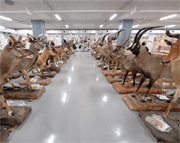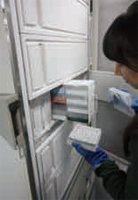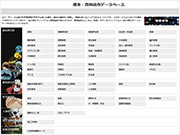
Collection

Collection room of mammals
(Natural History Collection
Wing 7F)
Specimens and materials contribute to current and future research, as well as helps deepen the public’s understanding of science through exhibitions and learning-support activities.
Building a “National Collection”

DNA and tissue
samples stored in
an ultra deep freezer
For quantitative research, it is necessary to collect a vast number of specimens and materials of the same kind. This is because even biological specimens from identical species, or specimens from identical minerals, are never completely identical. For example, specimens of creatures from the same kind may vary according to such factors as age, gender and habitat. In addition, successively collecting specimens from various regions over a long period of time will help us to learn about changes in habitat and so on.
To maintain various specimens and materials in good condition for the future, it is necessary to ensure an adequate control of temperature and humidity, as well as an adequate overall storage environment. It is also important to reserve additional storage space for the growing number of specimens and materials to come.
Dissemination of Information on Specimens and Materials

S-Net
The Museum, with cooperation of universities and museums throughout Japan, operates the“Science Museum Network (S-Net)”, an integrated search system for materials held by various institutions. The information is also disseminated on a global scale via the “Global Biodiversity Information Facility (GBIF)” an international service for global sharing and use of information on biodiversity. Further, the Museum operates the “Natural History Specimen Safety Net” in collaboration with numerous organizations, to prevent loss of valuable specimen and collections owned by universities and museums.
Materials for the history of science and technology are accessible to the public via the “Collection Database of Specimens and Materials,” and information obtained through collaboration with academic societies and industrial associations on science and technology are accessible via a database for “Database of materials on the history of industrial technology”. The Museum is also creating the “HITNET,” a common database for the history of industrial technology among industrial museums around Japan, which is similarly available to the public. Materials with particular importance for research are registered as “Essential Historical Materials for Science and Technology (otherwise known as: Future Technology Heritage).”
Digitalizing Specimens and Materials, and its Publication and Utilization

Collection Database of
Specimens and Materials
We are also creating digital archives of image data and other publicly available data to further promote the use of specimen and material information. Research materials and illustrated books are provided with easy to use form for both researchers and the public. These data are also available as electronic exhibits with commentaries.
New digital data are created every day with technology advances. They include high-definition photography, DNA information acquired from ancient specimens and 3-D digitalizations of specimens’ forms. From the perspective of preserving physical evidence, it is important to keep and store the specimens and materials together with their related data, and to pass them down to future generations, making use of them.